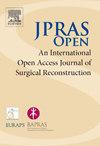‘Bucket Handle’ bipedicled flap for reconstruction of large scalp defects
IF 1.5
Q3 SURGERY
引用次数: 0
Abstract
Although advances in free flap surgery have allowed the reconstruction of a wide range of complex scalp defects, simpler local options continue to play a role. We describe how bipedicled or ‘bucket handle’ scalp flap with skin grafting of the donor site can be used to resurface large scalp defects of up to 15 cm x 20 cm.
This retrospective case series of 11 patients describes flap outcomes, post-operative complications, pathology and patient-related outcomes collected via a questionnaire.
Defect sizes ranged from 56 cm2 to 220 cm2. All 11 flaps survived with no readmissions or return to theatre. There were two minor post-operative infections. Pathologies requiring reconstruction were invasive squamous cell carcinoma involving the bone (45%), cranial bone necrosis after a cerebrovascular event (27%), trauma (9%) or cerebral malignancy (9%). Four patients (36%) underwent simultaneous cranial reconstruction with a cranioplasty plate. On an average, the patients who did not need to remain in the hospital for other reasons were discharged after two days. All patients reported subjective improvements in function post-operatively and that they were satisfied with the procedure.
This study suggests that large bipedicled scalp flaps with skin graft to the donor site are reliable, with positive patient-related outcomes and few post-operative complications. This technique is well suited for reconstructing long elliptical scalp defects created after the insertion of a cranioplasty plate. This procedure provides a robust alternative to patients who are unsuitable for free tissue transfer and those who may benefit from the short operative time and quick recovery time associated with a local flap.
用于重建大面积头皮缺损的 "水桶柄 "双蒂皮瓣
尽管游离皮瓣手术的进步使得各种复杂头皮缺损的重建成为可能,但更简单的局部选择仍在发挥作用。我们介绍了如何利用双蒂或 "桶柄 "头皮皮瓣和供皮部位的植皮来重塑高达 15 厘米 x 20 厘米的大面积头皮缺损。这组 11 例患者的回顾性病例系列描述了皮瓣效果、术后并发症、病理学以及通过问卷收集的患者相关结果。所有11个皮瓣都存活了下来,没有再入院或重返手术室。术后有两次轻微感染。需要进行重建的病理类型包括累及骨骼的浸润性鳞状细胞癌(45%)、脑血管事件后的颅骨坏死(27%)、外伤(9%)或脑部恶性肿瘤(9%)。有四名患者(36%)同时接受了颅骨整形板的颅骨重建手术。平均而言,无需因其他原因住院的患者两天后即可出院。这项研究表明,供皮部位植皮的大型双蒂头皮瓣是可靠的,患者相关结果良好,术后并发症较少。这项技术非常适合重建插入颅骨成形术钢板后形成的长椭圆形头皮缺损。对于那些不适合游离组织转移的患者,以及那些因局部皮瓣手术时间短、恢复快而受益的患者来说,这种手术方法是一种强有力的替代方案。
本文章由计算机程序翻译,如有差异,请以英文原文为准。
求助全文
约1分钟内获得全文
求助全文
来源期刊

JPRAS Open
Medicine-Surgery
CiteScore
1.60
自引率
0.00%
发文量
89
审稿时长
22 weeks
期刊介绍:
JPRAS Open is an international, open access journal dedicated to publishing case reports, short communications, and full-length articles. JPRAS Open will provide the most current source of information and references in plastic, reconstructive & aesthetic surgery. The Journal is based on the continued need to improve surgical care by providing highlights in general reconstructive surgery; cleft lip, palate and craniofacial surgery; head and neck surgery; skin cancer; breast surgery; hand surgery; lower limb trauma; burns; and aesthetic surgery. The Journal will provide authors with fast publication times.
 求助内容:
求助内容: 应助结果提醒方式:
应助结果提醒方式:


